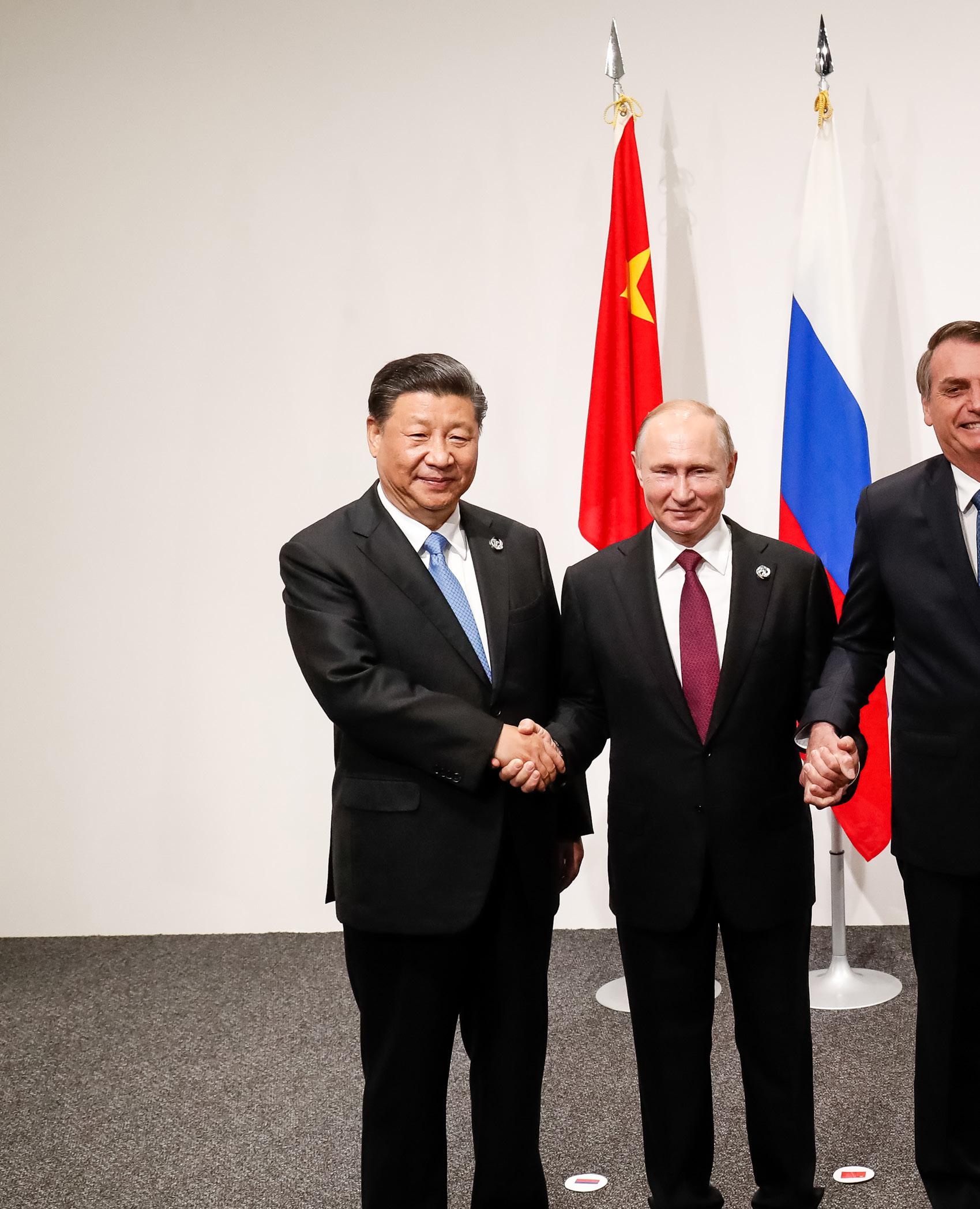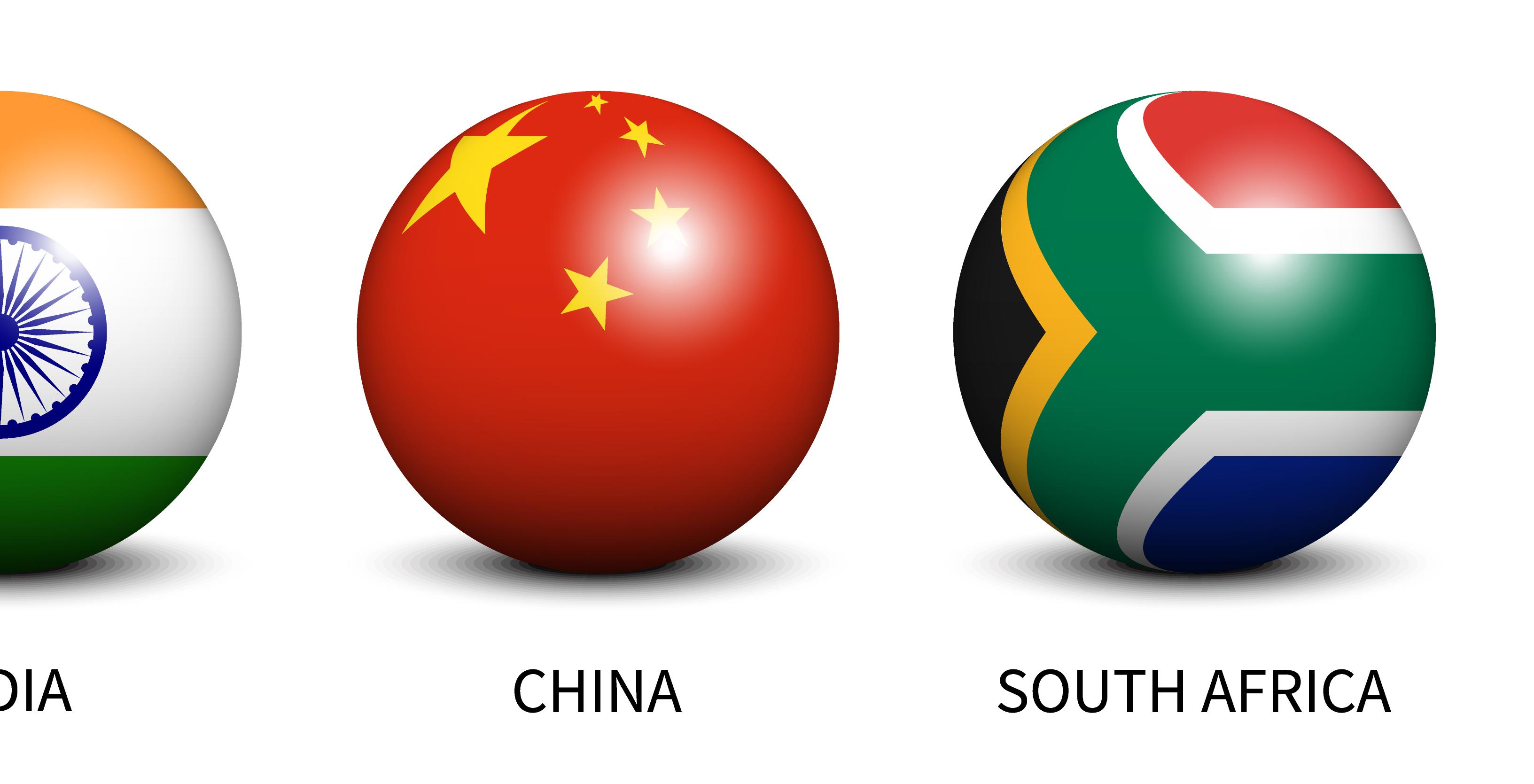ADVISORS
BRICS
IS THERE A THREAT TO THE U.S. DOLLAR?
IS THE CRYPTO WINTER OVER THE FUTURE OF AI THE DEBATE INTENSIFIES
ESOPS: THE SILVER TSUNAMI OF RETIREES

JUNE 2023 ISSUE 114 magazine

Erwin E. Kantor
Lumi Subasic
Michael Gordon
Jude Scinta
Lucas Rivera
Eric Daniels
Sean Rome
Erwin Kantor
Joe Innace
Regina Johnson
Amy Armstrong
Harold Gonzales
CEO & Publisher
Managing Partner
Managing Editor
Editor-in-Chief
Writer-at-Large
Billing
Creative Director
Creative Editor
Senior Writer


Feature Feature Writer
Feature Writer
Business Reporter
CONTRIBUTORS & GUESTS
Ty Young, Francesco Bisardi, BPT, Marileen Kern, Family Features
QUESTIONS

Headquartered at: 2598 E. Sunrise Blvd., Suite 2104, Fort Lauderdale, Florida, 33304 (917) 325 4191 Advisors Magazine is published bi-monthly and printed by Magcloud, Inc. Reproduction of any material from this print issue or our digital issue or transmitted in any form of by any means without prior written consent of the publisher in whole or in part is strictly prohibited. ©2023 by Advisors Magazine Inc. All rights reserved.
a free digital subscription email: editorial@advisorsmagazine.com To obtain a print issue, visit:
For
www.magcloud.com/user/advisorsmagazine
ADVERTISING creative@advisorsmagazine.com
& COMMENTS info@advisorsmagazine.com
EDITOR
ADVISORS MAGAZINE / 3
LETTERS TO THE
editorial@advisorsmagazine.com
AN ADVISOR MAGAZINE PUBLICATION @advisors.magazine @advisorsmagazin @advisorsmag
magazine
ADVISORS





contents JUNE 2023 6 Is the Crypto Winter Over Getting current on crypto MADE FOR YOU Our picks from the around the globe 24 4 / ADVISORS MAGAZINE JUNE 2023 features 16 Global currency challenges ON THE COVER BRICS Threatens Dollar 10 3 steps to guide you Retiring With Confidence 26 Debating the tough tech topic The Future of AI 6 16 10 26 30 ESOPs: The Silver Tsunami Waves of retirees create high stake moments for financial and wealth advisors 30
VION Receivable Investments, headquar tered in Atlanta, Georgia, is an international provider of receivable investment ser vices to businesses managing consumer and commercial receivables
VION provides a single , comprehensive source of exper tise in commercial receivable factoring and consumer receivable purchasing, valuations, and process consulting
VION Receivable Investments

400 Interstate North Parkway Suite 800 Atlanta, GA 30339 877.845.5242 phone 678.815.1557 fax
Mesquite Corporate Center 14646 N. Kierland Blvd. Suite 122 Scottsdale, AZ 85254 480.729.6419 phone 866.260.1826 fax
123 North College Avenue Suite 210B Fort Collins, CO 80524 877.845.5242 phone 970.672.8714 fax
11921 Freedom Drive Suite 550 Reston, VA 20190 703.736.8336 phone
VION Advisory Services 18017 Chatsworth Street Suite 28 Granada Hills, CA 91344 818.216.9882 phone 818.891.8738 fax
VION Europa
Paseo de la Castellana 95-15 (Torre Europa) Madrid 28046 Espanha +34 91 418 50 88 phone www.vioneuropa.es
RECEI
INVESTMENTS
Atlanta • Phoenix • For t Collins • Reston • Los Angeles • Madrid
V ABLE
By Francesco Bisardi
IS THE CRYPTO WINTER OVER?

The current situtation of the cryptocurrency world
Crypto prices have trended higher this year and, with a lingering recession and banking crisis, many investors have gone back to cryptocurrencies. Does this mean crypto winter is over?
Crypto prices have trended higher this year thanks to an encouraging inflation decrease, which could mean the Federal Reserve’s interest rates hikes might stop sooner than expected. With a lingering recession and the recent US banking crisis, many investors have gone back to the crypto world.
Bitcoin prices (BTC) rose above $30,000 in April and, despite a slight pullback, the oldest coin is up about 70% year-to-date in 2023.
Ethereum (ETH) prices rallied last month, after the completion of the Shanghai upgrade, a hard fork in the coin’s protocol (the non-upgraded version is no longer compatible with the updated one).
Does this mean the crypto winter, an extended period of trouble and pricing weakness in the cryptocurrency market, is finally over? “We are still in crypto winter, and companies are operating in survival mode, although many see the light out of the tunnel,” explains Francesco Bisardi, growth expert
and marketer with BitGo.
The 2022 crypto winter was characterized by a series of speculations but particularly by the implosion of FTX.
“The industry, along with those of us who contributed to the De-Fi (decentralized finance) development here in Silicon Valley in 2019, was disheartened by the significant setback caused by FTX, yet another Ce-Fi (centralized finance) project,” explains Bisardi, who has been an advisor for Vite Labs (Blockchain), Nonfiction Design, and TechCrunch.
What has alleviated the current crypto winter? At least two things:
1. Keeping the assets on-chain and/or using proof of reserve;
2. Market structure and proper regulations.
“If the first point is straightforward, the second might not be, and it is essential to comprehend the market structure as it affects the level of risk reduction in a market,” says the Italian-born blockchain expert Bisardi. “Because of their more complicated and diverse architecture, established trading markets (normal financial markets) are generally thought to reduce risk better than the crypto markets. In contrast, crypto
markets are frequently vertically operated, with exchanges (centralized entities) serving several functions, creating a single point of failure (FTX).”
Bisardi believes that understanding and enhancing the current market structure and creating a separation of duties to prevent fraud is critical for constructing a stable and safe crypto ecosystem.
When can we foresee the end of this crypto winter? “It’s not an easy question,” the Italian crypto
6 / ADVISORS MAGAZINE JUNE 2023
expert explains. “This is just my hunch, but it seems likely that we will need to wait until the end of 2023 or 2024 before we can confidently say that the crypto winter has come to an end and the next bull run has begun.”

Bisardi points out this is his own opinion and it’s not intended as financial advice.
The cryptocurrency market is relatively new, and currently, we are experiencing unique macrogeopolitical circumstances. Historically, the crypto market
has been cyclical; after a bull run, usually, we see a drop of 70-80% in terms of price and a stagnant market that can last for years.
“I believe BTC is the sole coin that truly embodies the concept of being a store of value. It is important to keep a close eye on the BTC dominance ratio as it can be a reliable indicator of market trends,” Bisardi explains.
Disclaimer: This article may contain forward-looking statements. Forward-looking statements describe future
expectations, plans, results, or strategies (including product offerings, regulatory plans and business plans) and may change without notice. You are cautioned that such statements are subject to a multitude of risks and uncertainties that could cause future circumstances, events, or results to differ materially from those projected in the forwardlooking statements, including the risks that actual results may differ materially from those projected in the forward-looking statements.
ADVISORS MAGAZINE / 7
© Robert Steenhoff | Dreamstime.com
“We are still in crypto winter, and companies are operating in survival mode, although many see the light out of the tunnel.”
Francesco Bisardi
Everest Consulting is a management and growth strategy consulting company that focuses on advising consumer branded lifestyle companies, from Fortune 500 companies to mid-sized organizations. With over 25 years of operating and management expertise, Everest Consulting provides the industry expertise along with the strategic and operational know how to help your brand achieve its fullest potential.
Everest Consulting is a management and growth strategy consulting company that focuses on advising consumer branded lifestyle companies, from Fortune 500 companies to mid-sized organizations. With over 25 years of operating and management expertise, Everest Consulting provides the industry expertise along with the strategic and operational know how to help your brand achieve its fullest potential.
www.everestconsultingcompany.com
www.everestconsultingcompany.com




8 / ADVISORS MAGAZINE SEPT 2022



www.everestconsultingcompany.com
Actionable
Breakthrough Strategies
HOW CONFIDENT ARE YOU THAT YOU’LL BE ABLE TO RETIRE
More Americans are retiring earlier than previous generations. According to a survey by the Federal Reserve Bank, their odds of retiring before age 62 rose to roughly 50% in July 2021, partly due to the pandemic.

10 / ADVISORS MAGAZINE JUNE 2023 ADVISOR FEATURE BY BPT

ADVISORS MAGAZINE / 11
For many, moving up their retirement seemed like the right choice given the state of the labor market and economy, but many were not and are still not financially prepared to retire.
According to a 2022 retirement confidence survey from the Employee Benefit Research Institute, one in three workers are “not too” or “not at all” confident they will have enough money to live comfortably throughout their retirement. And for those surveyed who say they are confident, retiring “comfortably” only covers the basics like housing, transportation, health care, food and utilities.
Retirement can mean a lot of things, but most people envision it as a time after their working life to enjoy things they may not have had the time to do before. While this looks different from person to person, many look forward to traveling, visiting family and enjoying hobbies.
Are you confident you will be able to retire with your basic expenses covered and enjoy the postwork life you’ve imagined? Check these three things.

1. Define your goals
After decades spent working, the prospect of retirement can feel sudden, and some people may have difficulty envisioning what it will look like. When you picture your retirement, what do you see yourself doing? Traveling abroad and checking cities off your bucket list? Paying for your children’s or grandchildren’s weddings? Setting up a legacy fund for your loved ones?
If you don’t yet know what you want out of retirement, start thinking now. Without clear goals, you won’t know how much money it will take to reach them. Beyond your core living expenses, consider how you would like to spend your time during your “go-go” (the first 10 years of retirement), “slow-go” years (middle retirement), and beyond.
2. See where you stand
Now that you have defined your goals, it’s time to see how your savings, investments, retirement accounts and other assets can support your desired retirement lifestyle. An easy way to check your
12 / ADVISORS MAGAZINE JUNE 2023
retirement readiness is to use an online platform like Prudential Stages for Retirement.
This digital tool will take the information you share about your current financial life and retirement goals to determine your personal “confidence score,” which indicates your retirement readiness. In a few steps, you will have a clearer picture of your retirement based on how you are saving and investing today.
3. Speak with an advisor
Once you have a clearer view of the big picture, you can meet with a financial advisor to help map out a step-by-step financial plan. If you do not have a financial advisor, you’re not alone.
Millions of Americans do not have a financial advisor. Some do not because they don’t know how to find someone they trust. Still others may feel an advisor is not for them, mistakenly thinking they need a certain level of wealth to engage a professional’s help. However, establishing a relationship with a financial advisor can help you confidently plan for a better retirement and even give you an edge.
According to the Warrington College of Business, industry data suggests that people who receive professional financial advice can add 1.5%-4% to their portfolio returns over time. Enlisting the help of a financial advisor can make planning for retirement easier and grow your wealth so you can achieve your retirement goals instead of having “just enough,” or even not enough.
Through Prudential Stages for Retirement, you can set up a meeting with a noncommission-based financial advisor who will recommend strategies and products that can help you reach your retirement goals. They will look at your retirement confidence score and establish a personalized plan to help you refine your goals and determine if you’re on track to afford your retirement. You do not have to be an existing Prudential customer; anyone can get started planning a more secure retirement. To learn more and get started, visit Prudential’s Retirement Calculator.

ADVISORS MAGAZINE / 13


Introducing... GIZMO, THE GOOFY COW for ages 4-10 and childlike adults too!
farmer hangs up his milking stool
she has to go to the auction barn.
her adventure as Gizmo
challenges in finding a new farmer but learns in the end that change
a good thing. Inspire a child today! All rights reserved. No part of this publication may be reproduced, distributed or transmitted in whole or in part or stored in a retrieval system or transmitted in any form or by any means including photography, recording or other electronic or mechanical methods without the prior written permission of the publisher, Amy M. Armstrong, except in the case of brief quotations embodied in critical reviews and certain other noncommerical uses permitted by copyright law. All images illustrated by Yoga D.C. Ariesta. For permission requests write to the publisher via email at: authoramyarmstrong@gmail.com ISBN: 978-0-578-42056-1 CLICK TO ORDER YOUR COPY NOW!
Marie Armstrong grew up on Long Lane Dairy in
Washington State. The farm is no longer owned
her
But
Gizmo was
"pets"
Gizmo
of the Future Farmers of America.
won a
grand champion for
and
Gizmo’s
and
Join
faces
can be
Amy
Western
by
family.
the memories of growing up there remain with her.
one of Amy's
on the farm and Amy showed
at the Northwest Washington Fair as a member
Gizmo
reserve
fitting
showing.
Contact Amy at authoramyarmstrong@gmail.com for info on bulk sales/fundraising/workshops opportunities
Amy earned a bachelor's degree in Communications with an emphasis in print journalism from Washington State University. She and husband Bob raised three children and lived in Alaska for 23 years after Bob retired from the Coast Guard. Amy was a community news journalist in Alaska receiving more than 60 awards for excellence in photography and writing. They now live in Florida and dote on their grandchildren.



Attorney Advertisement Elite N.Y. attorneys with over 40 years of combined experience! P: (914) 686-1500 • M: (914) 686-1504 E-mail: russell@yankwitt.com Please visit us a: www.yankwitt.com The Law Office of Civil | Commercial | Financial Securities | Healthcare 140 Grand Street, White Plains, New York 10601
by amy armstrong
OUTSIDE THREATS TO THE U.S. DOLLAR
MAY OUTWEIGH INTERNAL STRUGGLES

16 / ADVISORS MAGAZINE JUNE 2023
cover story
The BRICS leaders in 2019, from left to right: Xi Jinping, Vladimir Putin, Jair Bolsonaro, Narendra Modi and Cyril Ramaphosa

ADVISORS MAGAZINE / 17
(Photo: Alan Santos / PR)

18 / ADVISORS MAGAZINE JUNE 2023
Conditions beyond the control of the U.S. government may exist for a collapse of the almighty dollar.
Hyperinflation and government spending hallmarking the U.S. economy over the past three years haven’t helped keep the dollar’s value as stable as economists and everyday Americans had hoped.
However, a more likely trigger for the dollar’s precarious situation exists outside our nation’s borders.
It is the acronym BRICS, which stands for Brazil, Russia, India, China, and South Africa.
The leaders of this new monetary force are dedicated to challenging the U.S. dollar’s traditional role as the dominating global benchmark all other world currencies are measured against. A stated goal of BRICS is to create its own currency separate from the jurisdiction of the U.S. dollar. It wants a currency that its members can trade between just themselves and, effectively, eliminate the dollar’s influence.

“It (BRICS) would be like a new union of up-and-coming discontents who, on the scale of GDP (gross domestic product), now collectively outweigh not only the reigning hegemon, the United States, but the entire G-7 weight class put together,” wrote Joseph Sullivan – former staff economist at the White House Council of Economic Advisers during the Trump administration – in an April 24, 2023, online column for Foreign Policy. “Unlike competitors proposed in the past, like a digital yuan, this hypothetical currency actually has the potential to usurp, or at least shake, the dollar’s place on the throne.”
A Movement Gaining More Nations
Leadership from at least nineteen nations have expressed interest in joining BRICS, according to Anil Sooklal, South Africa’s representative to the group. He was quoted in a Times of
ADVISORS MAGAZINE / 19
AND GROWING B R I C S 5 COUNTRIES

20 / ADVISORS MAGAZINE JUNE 2023
India news article discussing the BRICS upcoming annual summit scheduled this year for June 2-3 in Cape Town, South Africa.
Included in the list of 19 are Algeria, Argentina, Bahrain, Egypt, Indonesia, Iran, Mexico, Nigeria, Saudi Arabia, Turkey, and the United Arab Emirates (UAE).
Admitting any number of these countries to its ranks would greatly increase BRICS worldwide reach. The organization began in 2006 as BRIC and added just one nation – South Africa – in 2010 to become BRICS.

As of now, the five nationmembers of BRICS represent 23 percent of the world’s economy and 18 percent of its
trade. Adding other nations to its roster will increase its worldwide power. According to Reuters, Saudi Arabia’s Public Investment Fund boasted $400 billion in 2020. The UAE is a technological destination nation with an impeccable credit rating. Its potential of joining BRICS would be a huge boost to the group’s credit rating worldwide, according to the Global Policy Journal.
Isn’t America Economic Besties with Some BRICS Intendeds?
The U.S. military has a strategic base in Turkey and our annual trade with Turkey was worth $21 billion in 2021. Mexico is our southern neighbor with whom we share
a border, an illegal immigration problem, and $780 billion in trading of goods annually. In 2021, the US exported more than $17 billion in goods to the UAE, according to the UAE’s embassy website. And, U.S. investment in Egypt topped $21.8 billion in the past 12 months. as quoted in The Exchange: Africa’s Investment Gateway. And, don’t we buy a lot of oil from Saudi Arabia?
Challenge to the International Monetary Fund and the World Bank
In 2022, China announced that the BRICS New Development Bank (NDB) would be headquartered in Shanghai. NDB is a $100 billion investment by the five BRICS
ADVISORS MAGAZINE / 21
nations in an effort to challenge the rule of the IMF and the World Bank.
Any financial transactions done at the NDB when it opens won’t be done in U.S. dollars.
To understand the importance of this shift, a short review of how the U.S. dollar became the dominant currency is in order.
A Little History Review
The U.S. dollar became the world’s economic standard in 1944 at the close of World War II when 730 representatives from 44 of the Allied nations voted in favor of creating a worldwide monetary system at an economic conference
dubbed the Bretton Woods Agreement. Held in Bretton Woods, New Hampshire, the international conference was a three-week effort resulting in the U.S. dollar becoming the currency all others would be measured up against worldwide. It also established fixed currency exchange rates with U.S. gold determined to be what backed up the new economic system.
Out of this conference, the International Monetary Fund (IMF) and the International Bank for Reconstruction and Development (IBRD) were formed, according to U.S. State Department online archives.

China, India, and Russia
(all now members of BRICS) were among the ten most active nations in the summit, according to archives accessible at www.worldbank. org.
Groundwork for the Bretton Woods Agreement – officially worldwide known as the United Nations Monetary and Financial Conference – was laid three years earlier at the Atlantic Conference in Newfoundland, Canada, in August 1941. This is when then U.S. President Franklin D. Roosevelt and then British Prime Minister Winston Churchill met on neutral territory to hammer out a plan for post-war recovery. Particularly noted were 1930s
22 / ADVISORS MAGAZINE JUNE 2023
economic conditions that the two leaders and their staff cited as causes for the European portion of the worldwide conflict.
Throughout the following decades, many other economic actions were taken – most notably in 1971 when then U.S. President Richard Nixon issued an executive order pursuant to the Economic Stabilization Act of 1970. The order ended the U.S. gold standard by eliminating direct conversion of the dollar to gold, except on the open market. It was called, “The Nixon Shock,” because he didn’t consult members of his own Cabinet or the IMF. The resulting worldwide
angst and the intervening decades during which the U.S. dollar continued to rule the global economic roost created an environment in which other world powers have sought to put their own thumbprint on economic activities.
Today, it isn’t too surprising that other nations representing other cultures want their own economic independence separate from a western mindset and U.S. dollars.
If nothing else, this should serve as a wake-up call that other countries are tiring of the American dollar heralded as the global benchmark, and that a paradigm shift may be on the horizon.

ADVISORS MAGAZINE / 23
The BRICS countries represent 43% of the world’s population, 16% of the world’s trade, and a larger share of the world’s GDP than the G7. Nineteen additional countries are reportedly interested in joining the alliance.
made for you
In a world of fast food and one-size-fits-all sensibilities, how often does something feel made especially for you? The "Made for You" section celebrates those items that are created with such high quality of hand workmanship and degree of customization that they become individual to you. In each issue, our editors will endeavor to bring you special things from anywhere on the globe, choosing them solely on the basis of outstanding quality. Our goal is to give you guidance on the best of everything.
A fragrance for the man who defies convention. A provocative blend of citrus and woody notes that liberates the senses. Fresh, clean and profoundly sensual. BLEU DE CHANEL unites the invigorating zest of grapefruit and the power of an aromatic accord with the whisper of dry cedar. A meeting of strength and elegance. BLEU DE CHANEL

When you’re looking to buy a reliable Pickup Truck, the only one that comes to mind is the Ford F-150. This best-seller has not only evolved but has been built to perfection. A turbocharged powertrain, with a hybrid option and aluminum body comes with all of Ford’s best technology. Ford now offers an upscale Platinum and Limited trim luxury option. Best Pick Up Truck in 2023. Ford 150 2023

Redbreast 21 Year Old Single Pot Still Irish Whiskey represents a style that’s truly unique to the nation. It’s distinguishing flavor profile and taste makes it especially exclusive. The brand seperates itself from the rest in this category. Concentrated sips coat the palate with a lingering finish. It keeps the party going with thoughtful talking points and charm.
Redbreast 21 year old whiskey

Montblanc is a distinguished brand when it comes to preserving the art and culture of writing. Since 1924, the Meisterstück pen has stood the test of time to become an iconic model known for its sleek, functional and ergonomic design. This German-made ballpoint version, expertly crafted from black resin, is fitted with platinumplated trims, the label’s white star emblem and an easy to use twist mechanism. Montblanc Ballpoint Pen

Davidoff Cigars – one of the most luxurious brands in the world. Zino Davidoff founded the brand and carried out the production of cigars in Cuba until 1990. Still, you’re probably wondering whether Davidoff cigars are any good or worth it. Without a doubt, these high-quality cigars are worth the hype. Davidoff Royal Release R

Verge Motorcycles announced it will start sales in select US states during 2023. By making a preliminary reservation, US fans can indicate their interest to be contacted when sales of the long-awaited electric motorcycles begin in the US. This groundbreaking technology enables a larger battery, longer range and stunning performance. In addition, the center of gravity is lower, which provides a better riding experience compared to traditional electric motorcycles. Verge Motorcycles
 1 BLEU DE CHANEL — EAU DE PARFUM SPRAY
2 IIRISH WHISKEY — REDBREAST 21 SINGLE POT
3 MONTBLANC MEISTERSTÜCK BALLPOINT PEN
4 BEST PICK UP TRUCK — 2023 FORD 150 RAPTOR
5 DAVIDOFF — ROYAL RELEASE ROBUSTO
1 BLEU DE CHANEL — EAU DE PARFUM SPRAY
2 IIRISH WHISKEY — REDBREAST 21 SINGLE POT
3 MONTBLANC MEISTERSTÜCK BALLPOINT PEN
4 BEST PICK UP TRUCK — 2023 FORD 150 RAPTOR
5 DAVIDOFF — ROYAL RELEASE ROBUSTO
1 3 4 5 6
6 VERGE — THE NEW VERGE TS ULTRA MODEL
2 24 / ADVISORS MAGAZINE JUNE 2023
Do


At Trupiano & Associates, we are dedicated to people first - you as a Family-owned business and your employees. Our priority is to help your Family Business thrive! That means that as an Independent Fiduciary Firm, we must by law do what is in our clients' best interest. We bring our exclusive approach, expertise, and experience to help your business and your employees work in a thriving and abundant environment.



CALL: 866.640.7897 EMAIL: Info@trupianoassociates.com www.trupianoassociates.com Investment advice offered through Safe Money Solutions, LLC, a registered investment adviser. Insurance services offered separately through Trupiano & Associates. A B U N D A N C E ! "Everyday, each of us tries to help somebody." Anthony Trupiano, CEO Brianna Taylor, Director of Marketing Sally Trupiano, CFO P L A N B E T T E R . L I V E B E T T E R .
you do just that.
We can help
to
and
and build the
you've envisioned? ) ( Group Benefits Wealth Management Business Insurance Individual Insurance 401 k & Profit Sharing
you want
attract
retain employees
company
by MERILEE kERN, MbA
DEBATING THE FUTURE OF AI: 15 Ways to Have Productive, Civil Conversations on a Contentious Tech Topic
Expert offers roadmap for having civil discourse on artificial intelligence—the preeminent hotbutton tech topic spurring heated discussions and disagreements
As the digital era rages on, perhaps no technology topic is more polarizing at the moment then that of Artificial Intelligence (AI) and Machine Learning (ML). Specifically, the role these rapidly emerging nextgen technologies will, and should, play in our daily lives and professions.
In the ever-expanding realm of AI, having civil conversations that address the potential and concerns surrounding this technology has become increasingly challenging. The

two most extreme camps—one fearing an apocalyptic future ruled by machines and the other advocating for unchecked AI development—clash vehemently, leaving little room (nor inclinations) for more nuanced discussions.
Recognizing the urgent need for far more open dialogue and understanding, Milan Kordestani, famed Gen Z author of the new, number one best-selling book “I’m Just Saying: A Guide to Maintaining Civil Discourse in an Increasingly Divided World,” provides the below insights to serve as a de facto roadmap for engaging in productive conversations about present and
future implications of AI and ML.
“The conversation surrounding AI is fueled by two extreme and polarized viewpoints,” explains Kordestani. “On one side, there are those who harbor deeprooted fears, reminiscent of dystopian sci-fi movies, wherein AI spells the demise of humanity. These individuals see AI as Skynet (of Terminator movie fame) come to life. This as an uncontrollable force that will override human control and wreak havoc on society. On the other side of the spectrum, there are proponents of unregulated AI development, who argue for unbridled advancement without consideration for potential job loss, ethical concerns, and
26 / ADVISORS MAGAZINE JUNE 2023
EDITORIAL COLUMN
socio-economic implications. This clash of ideologies creates an environment rife with hostility and ideological impasses.”
“The stakes are undeniably high when it comes to AI,” underscores Kordestani. “The fear-driven perspective believes that the very survival of humanity hangs in the balance, while the unregulated development camp emphasizes the limitless possibilities and potential for progress. Such deeply entrenched positions make it difficult to find common ground, and discussions often devolve into heated exchanges and stubborn resistance to opposing viewpoints. Moreover, the rapid pace of AI advancements and the
complex nature of its implications exacerbate the challenges, leaving little time for informed discourse and reflection.”
To combat this, Kordestani believes that having civil conversations about AI is crucial because the stakes are high and the impact of this technology on society at large is profound. The above strategies offer an easy-to-undertake though muchneeded roadmap for engaging in productive and respectful dialogue. By acknowledging fears, bridging gaps, educating, fostering collaboration, considering ethical implications, and encouraging long-term thinking, individuals can navigate
the minefield of AI discussions with nuance and openmindedness.
Kordestani’s strategies provided below, singularly and in combination, are intended to foster more civil discourse amidst the high-stakes nature of AI’s impact on society. Here’s how he suggests we can communicate more effectively and productively on the topic.
Consider Ethical Implications: Engage in discussions around the ethical dimensions of AI, such as data privacy, bias, and accountability. Encourage thoughtful examination of potential risks and safeguards to

ADVISORS MAGAZINE / 27
“I’m Just Saying: A Guide to Maintaining Civil Discourse in an Increasingly Divided World,” provides the below insights to serve as a de facto roadmap for engaging in productive conversations about present and future implications of AI and ML.
ensure responsible AI development.
Reflect on Your Own Position: Think about your own position within discussions about AI and reflect on your biases. Honestly evaluate your views, and determine if biases or intent is skewing your perspectives. Listen to your own tone and language to ensure you are being respectful.
Listen Actively: Acknowledge people’s fears and concerns genuinely. Actively listen to their questions, doubts, and criticisms. Create a safe space where they feel comfortable expressing their thoughts and emotions.

Empathize: Understand that fears and concerns about AI often stem from misinformation or a lack of understanding. Put yourself in their shoes and show empathy for their worries. Avoid dismissing or trivializing their concerns.
Provide Accurate Information: Offer clear, concise, and accurate explanations about AI. Avoid technical jargon and use simple language to ensure everyone can understand. Provide examples and real-life applications to illustrate how AI can be beneficial.
Discuss Current Regulations: Talk about existing regulations and policies in place to ensure the ethical and responsible use of AI. Explain how governments, organizations, and researchers are working together to address concerns and develop frameworks for AI governance.
Educate and Inform: Counter misinformation and misunderstandings about AI by providing accurate information
and insights. Share realworld examples of how AI is already improving lives and address concerns regarding job displacement, ethics, and transparency.
Address Potential Tisks:
Acknowledge the potential risks and challenges associated with AI, such as job displacement, ethical concerns, and privacy
issues. Discuss ongoing research and initiatives aimed at mitigating these risks. Highlight the importance of responsible AI development.
Showcase Benefits and Opportunities: While addressing fears and concerns, also emphasize the positive aspects of AI. Talk about the potential benefits, such as
28 / ADVISORS MAGAZINE JUNE 2023
improved healthcare, enhanced productivity, and personalized experiences. Highlight how AI can augment human capabilities rather than replace them.
Acknowledge Fears and Concerns: Start by validating the fears and concerns of those who envision a dystopian AI future. By acknowledging their perspective, a foundation for constructive dialogue can be established.
Encourage Long-Term Thinking: Shift the conversation from immediate fears to long-term perspectives. Explore the potential for AI to amplify human abilities, solve complex problems, and enhance various aspects of daily life.
Bridge the Gap: Emphasize the need for open-mindedness and the exploration of shared values. Look for common ground, such as the desire to ensure ethical AI development or the pursuit of technologies that benefit society as a whole.
Involve Diverse Perspectives: Ensure that discussions about AI involve diverse voices and perspectives. Include experts from various fields, policymakers, ethicists, and individuals directly impacted by AI to provide a wellrounded understanding of the topic.
Be Transparent: Maintain transparency about AI development, deployment, and decision-making processes. Discuss data handling practices, algorithmic biases, and any potential risks openly.
Transparency fosters trust and helps address concerns about AI’s impact on society.
Foster Collaboration: Encourage collaboration between technology experts, policymakers, ethicists, and other stakeholders to collectively shape AI’s trajectory. Highlight the importance of interdisciplinary dialogue and the need to find balanced solutions.
The urgency to leave behind extreme positions and embrace civil discourse is paramount. Only through respectful and informed conversations can we find common ground, address concerns, and work towards a future where AI is harnessed as a tool that benefits humanity. By following Kordestani’s guidance and approaching AI discussions with empathy, knowledge and a genuine desire to understand different perspectives, we can collectively shape the trajectory of AI in a responsible and inclusive manner.
In this era of rapid technological advancements, the need for civil conversations about AI cannot be overstated. Let us rise above the heated battles and engage in meaningful exchanges that pave the way for a future where AI is accurately represented and understood—even amid differing positions about its cultural value.
Merilee Kern, MBA is an internationally-regarded brand strategist and analyst who reports on noteworthy industry change makers, movers, shakers and innovators across all B2B and B2C categories. This includes field experts and thought leaders, brands, products, services, destinations and events. Merilee is Founder, Executive Editor and Producer of “The Luxe List” as well as Host of the “Savvy Ventures” business TV show that airs nationally on FOX Business TV and Bloomberg TV and the “Savvy Living” lifestyle TV show that airs in New York, Los Angeles, San Francisco, Miami, Atlanta and other major markets on CBS, FOX and other top networks. As a prolific business and consumer trends, lifestyle and leisure industry voice of authority and tastemaker, she keeps her finger on the pulse of the marketplace in search of new and innovative must-haves and exemplary experiences at all price points, from the affordable to the extreme—also delving into the minds behind the brands. Her work reaches multimillions worldwide via broadcast TV (her own shows and copious others on which she appears) as well as a myriad of print and online publications. Connect with her at www.TheLuxeList. com and www.SavvyLiving. tv / Instagram www.Instagram. com/MerileeKern / Twitter www.Twitter.com/MerileeKern / Facebook www.Facebook. com/MerileeKernOfficial / LinkedIN www.LinkedIn.com/in/ MerileeKern.
ADVISORS MAGAZINE / 29
By Lawrence Kaplan Founder & Managing Partner, CSG Partners
ESOPS: A SAFE HARBOR AMIDST THE SILVER TSUNAMI
The United States is getting older. By 2035, 76 million Americans will be aged 65 or above. That’s up from 58 million in 2022.
This “Silver Tsunami” represents a high stakes moment for financial and wealth advisors. Waves of retirees will put the tenets of careful planning to the test. But this demographic shift also threatens to disrupt every aspect of society.

Take, for example, closely-held businesses. The number of owners at full retirement age rose 87% between 2000 and 2020. This trend continues to accelerate, and its social and economic impact could be profound.
Americans over 55 own half of all US businesses.
These 2.9 million companies – ranging from mom-and-pop outfits to middle market firms –account for 32 million employees, according to Project Equity. Combined, they take home $1.3 trillion in wages and generate roughly $6.5 trillion in revenue each year.
With that many livelihoods on the line, a mass shake-up of closely-held companies could reverberate through the economy. When private businesses leave a community, or fail altogether, locals typically struggle to find equivalent work and local governments lose reliable sources of tax revenue. Mounting waves of retirees falling off payrolls will only compound this
issue.
Academics Erika James and Lynn Perry Wooten describe this as a “smoldering crisis.” Job losses, associated wage compression, and an aging population will gradually increase social welfare dependency. Despite a need for additional government resources, diminished income tax revenues will likely erode the social safety net and put added pressure on forprofit service providers. That could send nationwide living standards spiraling downward.
Orderly business transitions could blunt
the Silver Tsunami’s impact.
Unfortunately, rigorous succession planning isn’t a common practice among many closely-held businesses. According to a recent survey, 67% of lower middle market owners who put their businesses up for sale in 2022 did so without solidifying a formal exit plan in the year prior.
The absence of a plan increases
30 / ADVISORS MAGAZINE JUNE 2023
ADVISOR
FEATURE
an owner’s risk of subpar transaction pricing, selling under duress, or struggling to find a buyer at all. Generational succession used to be a backstop in these situations, and it was often a preferred strategy. That’s also become thing of the past.
Millions of working-class Americans are relying on aging business owners to craft thoughtful exit and succession plans. Soaring interest rates and shifting market conditions, though, make sensible, stable paths harder to find.
Some owners have found safe harbor in an underutilized strategy.
Employee stock ownership plans were formalized as part of ERISA in 1974. A legislative “cousin” of the 401(k), ESOPs are often pigeon-holed as benefits programs. While these plans offer retirement incentives to nearly 14 million employee-owners nationwide, ESOPs can also function as M&A alternatives.
Unique among defined contribution plans, ESOPs offer participants stock in a sponsoring company, rather than a third-party entity. A sponsor can contribute shares directly to an employee stock ownership trust, but it can also sell equity to a trust at a fair market valuation. Known as a leveraged ESOP, this strategy enables shareholders of closelyheld businesses to gradually divest from their companies or execute a complete liquidity event.
Post transaction, an employeeowned company remains in-tact.
Unlike a third-party sale, an ESOPowned company’s board of directors continues to manage the business. Meanwhile, employees not only keep their jobs, they earn annual stock allocations at no out-of-pocket
cost.
Selling shareholders often choose to maintain meaningful roles. Some continue as guiding figures. Others gradually phase out their day-to-day responsibilities and help pass the helm to a next generation of leaders. In many respects, the stability afforded by an ESOP reflects that of a generational transfer – just to a bigger “family.”
Employee stock ownership plans also offer competitive advantages.
ESOP-specific tax deductions enhance corporate cash flow, while the employee stock benefit often bolsters a company’s ability to hire and retain staff. The promise of stock appreciation drives increased productivity. The latter is described as employee-ownership culture, and its competitive impact has been documented and researched for decades.
These benefits cannot be expected to keep a struggling company afloat, and there are also managerial and financial costs associated with maintaining an ESOP. But an already productive business should be better positioned to navigate the Silver Tsunami under an employee ownership model. That could be a boon for both loyal employees and their broader communities.
The relative attainability and flexibility of an ESOP adds to the transaction’s appeal.
Although plan formation has its rigors, there are fewer outside variables than a typical M&A deal. The sponsor company is neither marketing itself to a broad range of potential buyers nor exposing confidential information to potential competitors. Instead,
a company negotiates the transaction with a known, albeit independent, entity: an employee trust.
Even when a business lacks a fully articulated succession plan, a partial ESOP sale can create shareholder liquidity while buying precious time to build a formal strategy. That’s because companies have the freedom to engage in subsequent transactions including secondary ESOP sales, stock buybacks, and plan terminations. Even third-party M&A is an option.
Employee ownership isn’t a panacea, but it could help save America’s private businesses. Companies with less than 500 employees employed more than half of the US private sector labor force as recently as the late 1990’s. That percentage dipped to 46.4% in 2019. By all initial accounts, the Coronavirus pandemic accelerated this trend.
Roughly 35% of small businesses active prior to the pandemic remained closed as of May 2021. Those that stayed afloat were more acutely challenged by price increases, labor shortages, and higher borrowing costs than their larger competitors. Small business sentiment has waned, and local economies have been uniquely impacted.
If the past is prologue, the Silver Tsunami is a credible threat to America’s closely-held business community. Business owners, and their trusted advisors, can still get ahead of the wave, but now is the time for thoughtful planning and new ideas. A fresh look at employee ownership could be a saving grace for private companies and the communities they call home.
ADVISORS MAGAZINE / 31
Give Your Employees Financial Education, And They’ll Give You More Productivity














Recent studies all point to one conclusion that impacts employers across the U.S.: The majority of employees worry more about their finances, now more than ever. That stress makes them less productive today, and every day. In fact, 15.3 hours of productivity and engagement are lost by each financially-stressed employee each week. And that affects the bottom line.
The Harmonize™ Retirement Planning Program partners with Vanguard® to customize retirement plans to fit the needs of each individual at every level. To find out more, contact Pat Harmon at harmonizefinancial.com.













The sooner you start, the sooner your workforce gets more productive.

HarmonizeFinancial.com Small Business Retirement Plans Small Business Retirement Plans Source: Brightplan, 2021 Wellness Barometer Survey








































 1 BLEU DE CHANEL — EAU DE PARFUM SPRAY
2 IIRISH WHISKEY — REDBREAST 21 SINGLE POT
3 MONTBLANC MEISTERSTÜCK BALLPOINT PEN
4 BEST PICK UP TRUCK — 2023 FORD 150 RAPTOR
5 DAVIDOFF — ROYAL RELEASE ROBUSTO
1 BLEU DE CHANEL — EAU DE PARFUM SPRAY
2 IIRISH WHISKEY — REDBREAST 21 SINGLE POT
3 MONTBLANC MEISTERSTÜCK BALLPOINT PEN
4 BEST PICK UP TRUCK — 2023 FORD 150 RAPTOR
5 DAVIDOFF — ROYAL RELEASE ROBUSTO











































